ADVENTURES AND ORDEALS WITH A FOLDING PROA ON
THE YUCATAN COAST
Appendix 1. All about the boat with plans
and diagrams.Copyright 2001 Tim Anderson
Why are the diagrams kind of weird? Generally the diagrams show the boat
as it is. Three sticks that do the same job will be three different materials
and sizes. This isn't meant to be ideal, but it's useful to me.
What is a "Flying Proa"? Proa means "boat"
in Malay, but Malays don't use this kind of boat. I guess a Euro asked a
Malay what that thing in the distance was. "Flying" because the
outrigger is flying over the water a lot of the time and because it was
the fastest boat at the time of contact.
It's sailed with the outrigger always to windward. Instead of tacking through
the eye of the wind you carry the sail to the other end and back up. The
Marshallese call the move "Riak". Roll the 'r' once and the 'a'
is kind of like a 'u' as in "duck". Anglos call it "shunting"
because it reminded someone of what a train did on a steep grade. If it's
too steep to build a turn in the track, the train overshoots onto a dead
end track and then backs up the next section.
This particular boat is a mishmash of ideas from
the Marshall Islands, Kiribati, inflatable boats, umiaks. The gaps are filled
with hubris and lashings of innertubes.
I need to add more rigging and lashing details to this document, but in
the mean time that information is available elsewhere.
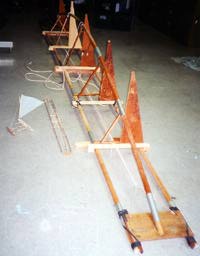
The ascent of canoe. 1/32 model, 1/8 hull model, and fullsize canoe
hull frame. Mid-January.
Every piece that came on the airplane was in 38"
sections in bags 12x12x38" which is under the 62 inch sum-of-dimensions
checked bag limit. Most folding canoes violate this limit. I don't know
why. Maybe because they want the long spars in four sections rather than
five. For this reason many accounts of airplane trips with folding canoes
involve unexpected excess baggage charges.

Main hull. 15" 16" 1.5-2" sheer 24"
17'7" circular arc. 6 sections 38" long.
The Main Hull:
The main hull is a white abstract sculpture 17' 7" long. The keel is
a circular arc which joins the gunwales at the bows with headboards like
an umiak. The hull has a deep vee shape and is of skin-on-frame construction.
The skeleton is composed of two gunwales, a keel, 5 triangular ribs, and
two headboards.
So from the top it looks rectangular, from the side it's a slice of orange,
and from the front it's a wedge. The skin is hypalon on 4 oz. polyester
canvas laced over the deck like a corset. This was too elastic, so I added
a layer of heavy silver polytarp. 8 oz polyester would probably be enough
for a single layer skin.
The hull has 2-3" sheer, 24" depth amidships, 16" beam in
the middle, 15" at the ends. It has about as much asymmetry as you
might get by accident, an inch or so. Put the fat side toward the outrigger.
You can set it up with more sheer or more asymmetry.
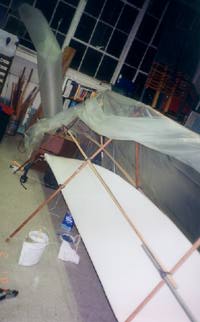
Painting Hypalon coating on polyester canoe skin. Then covered with
tent with exhaust fan. The xylene fumes are unpleasant and explosive.
Top and front views of Headboard assembly. a: gunwales
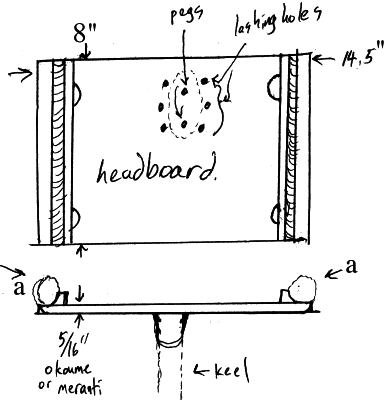
Top view of canoe hull and deck assembly:
.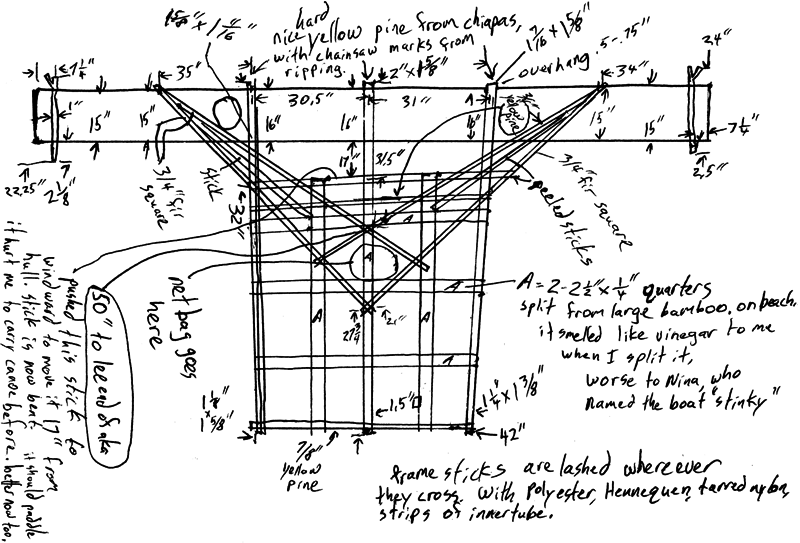
Top view details. Hull skin and part of deck: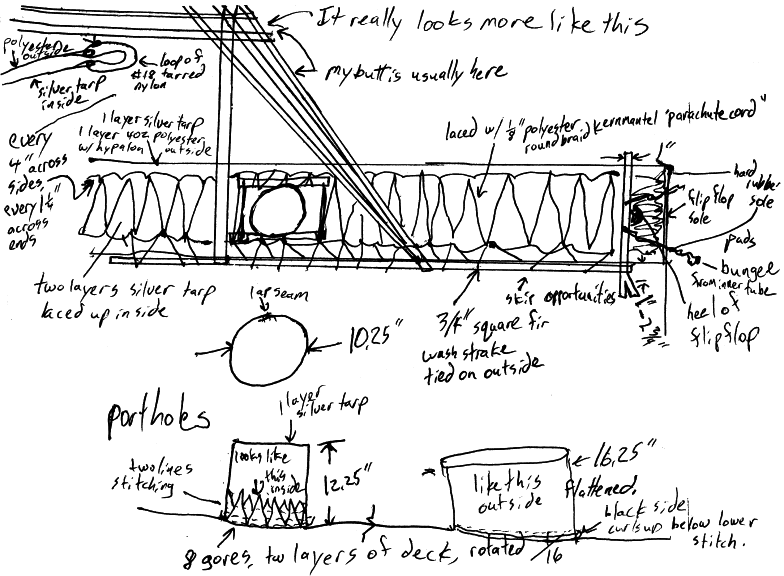
The Outrigger:
The outrigger is a buoyant pink and white cigar just under 10ft long.
It has a polyester skin zipped over a frame and some float bags like a dirigible.
It has a circular arc keel and straight sheer in side view and round crossections.
The outrigger is 114"=9'6" long. This is the length of the three
38" sections
of 1.5" dia aluminum tubing that compose its spine.
The outrigger is 8.5" in diameter and tapers at each end to the size
of a tennis ball. Under the skin there is a tennis ball at each end, cut
off and jammed over the end of spine and keel. The keel is .75" oak.
At two places two .63" oak dowels push the keel away from the spine
and protrude up through the skin a foot. These are lashed to two of the
akas, which are three 102"=8'6" long yellow pine2x2's.
Perspective view of outrigger and outrigger-to-crossbeam
connections.

Internal frame of outrigger float. Side and front
views.

tennis ball. lashing. 1.5" 10" .625"
oak 19.75" 8.5-9.5" 3/4" oak from frat floorboards in dumpster.
1.68"=15/8" butt blocks. aluminum tube from aqua-cat. 38"x3=114"=9'6"
The first time I didn't use butt blocks. I just lapped them. Lashed with
strip of bicycle innertube like all the other joints.
Later I changed to butt blocks as in the drawing and re-lashed with #18
tarred nylon "palapa string".
Pattern for outrigger skin.

Straight section 46" long. tennis ball fits in
here. 9'6" 39" 13.25" zipper parting at this end. double
parting zippers. It's cut from a Tiga Neil Pryde windsurfer sail.
Includes different weights polyester sailcloth with a hard finish and a
chunk of vinyl window.
The Sail:
The triangular sail is 11 sq. meters of blue polytarp.
A boomed lateen "crab claw" with yard and boom in pockets.
An equilateral triangle with some traditional unintuitive rounding of leech
and foot. This sail is very good and my next will be much like it.
Boom and yard are tapered tubular fiberglass, thin at the ends and fat in
the middle. Each section has a smaller insert glued into the end that fits
into the next section. Boom and yard are just a little shorter than the
main hull. I had some trouble figuring these out because the taper changes
the length of the inserts, and that is subtracted from 38" to get the
length of the tube. So I couldn't know ahead of time how long they would
be, cuz I didn't know the taper. So I built them section by section and
measured them afterward.
I cut up many windsurfer masts in order to make them.
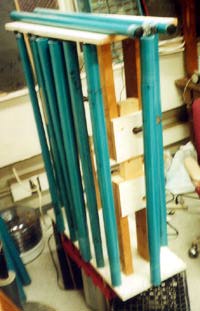
38" Sections of boom and yard. Epoxy joint inserts are curing.
The original sail was too large and created put the center of effort
too far aft. This caused excessive weather helm and steering problems. I
recut the sail as follows. I also have a diagram somewhere of the original
sail. Cut an extra 1.5" into ther first quarter of the foot by the
tack. Cut 1.5" less cloth into the leech at the outer quarters. Cut
an extra 1.5" into the center half of the leech. all dimensions are
to outer crease of the spar pockets. There's a 1/16" polyester leech
line that can be tightened to cup the leech slightly. There are no curves
in the edges of this sail except the middle half of the leech. That is a
fair curve, but it could also be straight lines if you prefer. Many thanks
to Augustine Nakamura of Namorik Atoll for these rules of sail cut.
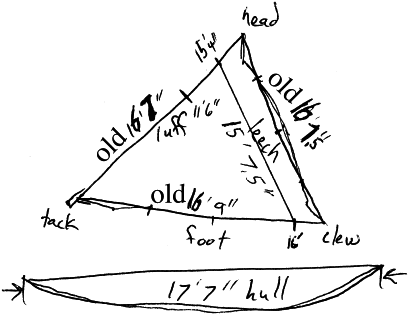
Sorry about the bad drawing. Time is running out. "Tack" is the
part of the sail that rests on the bow. 11'6" marks where the halyard
is tied to the yard. The sheet is tied to the boom a foot or so aft the
midpoint of the boom. I usually make the sheet perpendicular to the boom
when the sail is close-hauled.
The orientation of the fibers in the sail is very
important. It determines how the sail stretches and changes shape in different
strengths of wind.
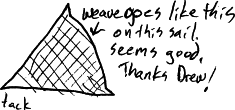 Tack. Weave is
oriented like this on the sail. Fibers are parallel to the yard. Seems good.
Thanks Drew!
Tack. Weave is
oriented like this on the sail. Fibers are parallel to the yard. Seems good.
Thanks Drew!
How to attach tie points and straps to a spar:
Dip the end of a loop of nylon strap in melted wax. This keeps it
from soaking up epoxy so it will stay flexible.
This keeps it
from soaking up epoxy so it will stay flexible.
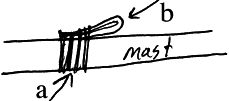 (b) Lash it to the mast with polyester or nylon string.(a)
then soak the lashing with epoxy. For models, soak the lashings with superglue.
This works very well.
(b) Lash it to the mast with polyester or nylon string.(a)
then soak the lashing with epoxy. For models, soak the lashings with superglue.
This works very well.
I couldn't have handled the waves and swells without
the Kiribati(pronounced Kiribus for reasons known to the Gilbertese) style
sweep oar steering.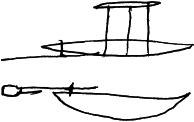 Even
with all this leverage, I had to use enough force to bend the oar extension
pretty far sometimes with waves surfing the stern around. It's a sapling
pole tapering from ~2" down to just over an inch over about 7ft.
Even
with all this leverage, I had to use enough force to bend the oar extension
pretty far sometimes with waves surfing the stern around. It's a sapling
pole tapering from ~2" down to just over an inch over about 7ft.
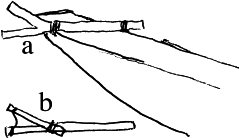 (a) is a place to rest the steering oar. lash it in
with string or innertube for rough conditions. (b) is a design if you can't
find a grown fork or if you want it to fold.
(a) is a place to rest the steering oar. lash it in
with string or innertube for rough conditions. (b) is a design if you can't
find a grown fork or if you want it to fold.
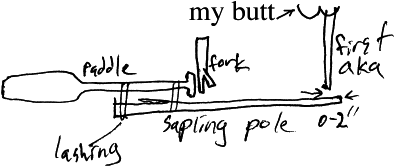 The oar is this long. paddle.
fork. first aka. lashings. sapling pole. 0-2" I don't know the routine
for tying the oar at the new end. Fouls up my routine. And it's a long thing.
The oar is this long. paddle.
fork. first aka. lashings. sapling pole. 0-2" I don't know the routine
for tying the oar at the new end. Fouls up my routine. And it's a long thing.
 (a)Step the mast anywhere.
(a)Step the mast anywhere.
 Carry bag for boat is
sleepingbag. 24x50" envelope exactly covers 12x12x38" box. 34"x56"
size of yellow/orange bag is good. Lifejacket is foam pad for sleeping.
Carry bag for boat is
sleepingbag. 24x50" envelope exactly covers 12x12x38" box. 34"x56"
size of yellow/orange bag is good. Lifejacket is foam pad for sleeping.
MISC NOTES:
Hull and outrigger need "shoes" so I can
drag them over rocks.
Main hull needs to be well sealed.
Float bags bigger, better shaped than airmattresses so hull is smooth.
Skin must be >8oz. or so, or it will stretch rather than tightening enough.
Pole sections need to be sealed and thinner at the ends so they don't swell
up and bind in the joints.
Need larger bore bailer pump. Empty the hull faster. Drain hole by keel?
Automatic bailer port in hull like flatwater racing canoes and shells?
THINGS THAT DON'T WORK:
Nylon elongates ~10% when wet and is slippery.
Nylon lashings will work themselves loose when dried and soaked repeatedly.
They need to be tied off very securely or encapsulated with epoxy, tar,
or somesuch.
Nylon cloth sails will change their shape too much when wet. Use something
else like polyester or blue tarp.
Nylon hull skin must be encapsulated with something impermeable. Latex paint
or snoseal rubber paint doesn't do it. Hypalon with lots of thinner, neoprene
ditto will work. Tar is probably excellent for this.
Manntech has a urethane coating. It will not weld well to pvc. Weld on a
urethane fitting instead.
The mainstay changes sail trim the wrong way when it stretches. Use steel
cable or the least elastic thing you can find.
TOP
Copyright 2001 Tim Anderson











 Tack. Weave is
oriented like this on the sail. Fibers are parallel to the yard. Seems good.
Thanks Drew!
Tack. Weave is
oriented like this on the sail. Fibers are parallel to the yard. Seems good.
Thanks Drew!  This keeps it
from soaking up epoxy so it will stay flexible.
This keeps it
from soaking up epoxy so it will stay flexible. (b) Lash it to the mast with polyester or nylon string.(a)
then soak the lashing with epoxy. For models, soak the lashings with superglue.
This works very well.
(b) Lash it to the mast with polyester or nylon string.(a)
then soak the lashing with epoxy. For models, soak the lashings with superglue.
This works very well. Even
with all this leverage, I had to use enough force to bend the oar extension
pretty far sometimes with waves surfing the stern around. It's a sapling
pole tapering from ~2" down to just over an inch over about 7ft.
Even
with all this leverage, I had to use enough force to bend the oar extension
pretty far sometimes with waves surfing the stern around. It's a sapling
pole tapering from ~2" down to just over an inch over about 7ft. (a) is a place to rest the steering oar. lash it in
with string or innertube for rough conditions. (b) is a design if you can't
find a grown fork or if you want it to fold.
(a) is a place to rest the steering oar. lash it in
with string or innertube for rough conditions. (b) is a design if you can't
find a grown fork or if you want it to fold. The oar is this long. paddle.
fork. first aka. lashings. sapling pole. 0-2" I don't know the routine
for tying the oar at the new end. Fouls up my routine. And it's a long thing.
The oar is this long. paddle.
fork. first aka. lashings. sapling pole. 0-2" I don't know the routine
for tying the oar at the new end. Fouls up my routine. And it's a long thing. (a)Step the mast anywhere.
(a)Step the mast anywhere. Carry bag for boat is
sleepingbag. 24x50" envelope exactly covers 12x12x38" box. 34"x56"
size of yellow/orange bag is good. Lifejacket is foam pad for sleeping.
Carry bag for boat is
sleepingbag. 24x50" envelope exactly covers 12x12x38" box. 34"x56"
size of yellow/orange bag is good. Lifejacket is foam pad for sleeping.